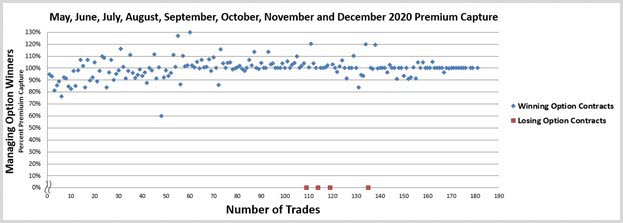Generating consistent monthly income in a high probability manner in both bear and bull markets is the luxury of options trading. The core of options trading is defining risk, leveraging a minimal amount of capital, and maximizing returns. They enable smooth and consistent portfolio appreciation without guessing which way the market will move. An options-based portfolio performance demonstrates the durability and resiliency of options trading as a means to drive portfolio results.
An agile options-based portfolio is essential to navigate pockets of volatility and mitigate market downdrafts. The recent September correction, October nosedive, and election volatility into November are prime examples of why risk management is paramount. Despite the recent market volatility, positive returns in all three market scenarios were generated. Over the past 6-plus months, 171 trades were placed and closed. A win rate of 98% was achieved with an average ROI per trade of 7.6% and an overall option premium capture of 89% while matching returns of the broader market and outperforming during market downswings (Figures 1 and 2).

Figure 1 – Overall option metrics from May 2020 – December 4th, 2020

Figure 2 – Overall option metrics from May 2020 – December 4th, 2020
Positive Returns Despite September, October, and November Volatility:
The recent September correction, tail end October nosedive, and election-induced highly volatile early November provides an excellent opportunity to demonstrate an options-based portfolio's durability and resiliency. A positive $1,251 return, a positive $2,585 return, and a positive $2,797 return for the portfolio's options portion were achieved in September, October, and November, respectively (Figure 3).

Figure 3 – Generating consistent income despite negative returns for the S&P 500 index
The positive options returns were in sharp contrast to the overall market's negative returns in September and October. Generating consistent income without guessing which way the market will move with the probability of success in your favor has proven successful despite these market conditions.
Options Results
Compared to the broader S&P 500 index, the blended options, long equity and cash portfolio have matched this index. In even the most bullish scenario post-COVID-19 lows where the markets erased all the declines inflicted by the pandemic, this approach has kept pace with the S&P 500 returns through 30NOV20 with substantially less risk (Figures 4, 5, and 6).
Overall, in May, June, July, August, September, October, and November, 1xx trades were placed and closed. A win rate of 98% was achieved with an average ROI per trade of 7.6% and an overall option premium capture of 89% while outperforming the broader market through the September, October, and initial November volatility (Figures 1, 2, 3, 4, 5 and 6).

Figure 4 – ROI per trade over the past ~180 trades

Figure 5 – Percent premium capture per trade over the last ~180 trades

Figure 6 – Smooth and consistent portfolio appreciation while matching the broader market gains and outperforming during the market sell-off in September and October. An overlay of an options/cash/long equity hybrid portfolio and the S&P 500. Even under the most bullish conditions, the hybrid portfolio has matched or outperformed the index with a ~50% cash position
10 Rules for an Agile Options Strategy
Risk management is paramount when engaging in options trading. A slew of protective measures should be deployed if options are used as a means to drive portfolio results. When selling options and running an options-based portfolio, the following guidelines are essential:
-
1. Trade across a wide array of uncorrelated tickers
2. Maximize sector diversity
3. Spread option contracts over various expiration dates
4. Sell options in high implied volatility environments
5. Manage winning trades
6. Use defined-risk trades
7. Maintains a ~50% cash level
8. Maximize the number of trades, so the probabilities play out to the expected outcomes
9. Continue to trade through all market environments
10. Appropriate position sizing/trade allocation
Conclusion
The dual threats of the election and resurgence of COVID-19 cases domestically and abroad were volatility events that investors need to heed. The September correction, tail end October nosedive, and initial November volatility reinforces why appropriate risk management is essential. An options-based approach provides a margin of safety while circumventing the impacts of drastic market moves and contains portfolio volatility. Despite these market conditions, consistent monthly income was generated while keeping pace with the broader market returns and outperforming during periods of market weakness.
Sticking to the core fundamentals of options trading, one can leverage small amounts of capital, define risk, and maximize investment return. Following the 10 rules in options, trading has generated positive returns in all market conditions for the portfolio's options segment. The positive options returns were in sharp contrast to the overall market's negative returns in September and October. This negative backdrop demonstrates an options-based portfolio's durability and resiliency to outperform during pockets of market turbulence. To this end, cash-on-hand exposure to broad-based ETFs and options is an ideal mix to achieve the portfolio agility required to mitigate uncertainty and volatility expansion.
Thanks for reading,
The INO.com Team
Disclosure: The author holds shares in AAPL, AMZN, DIA, GOOGL, JPM, MSFT, QQQ, SPY and USO. The author has no business relationship with any companies mentioned in this article. This article is not intended to be a recommendation to buy or sell any stock or ETF mentioned.
